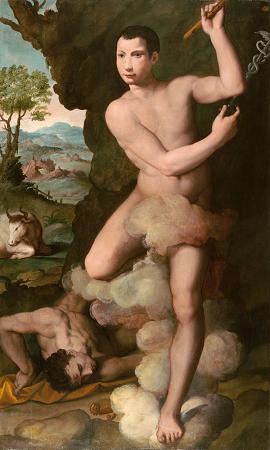Argus. Killed by Mercury on order of Zeus. Argus Panoptes or Argos is a many-eyed giant in Greek mythology. The figure is known for having generated the saying the eyes of Argus, as in to be followed by the eyes of Argus, or trailed by them, or watched by them, etc. These terms are used to describe being subject to strict scrutiny in one's actions to an invasive, distressing degree. The monstrous entity has been either directly included or indirectly alluded to in a wide variety of works influenced by Greco-Roman thought over the past several centuries. Argus Panoptes, guardian of the heifer-nymph Io and son of Arestor and probably Mycene, was a primordial giant whose epithet, Panoptes, all-seeing, led to his being described with multiple, often one hundred, eyes. The epithet Panoptes was applied to the Titan of the Sun, Helios, and was taken up as an epithet by Zeus, Zeus Panoptes. In a way, Walter Burkert observes, the power and order of Argos the city are embodied in Argos the neatherd, lord of the herd and lord of the land, whose name itself is the name of the land. The epithet Panoptes, reflecting his mythic role, set by Hera as a very effective watchman of Io, was described in a fragment of a lost poem Aigimios, attributed to Hesiod: And set a watcher upon her, great and strong Argus, who with four eyes looks every way. And the goddess stirred in him unwearying strength: sleep never fell upon his eyes; but he kept sure watch always. In the 5th century and later, Argus' wakeful alertness was explained for an increasingly literal culture as his having so many eyes that only a few of the eyes would sleep at a time: there were always eyes still awake. In the 2nd century AD Pausanias noted at Argos, in the temple of Zeus Larissaios, an archaic image of Zeus with a third eye in the center of his forehead, allegedly Priam's Zeus Herkeios purloined from Troy. Argus was Hera's servant. His great service to the Olympian pantheon was to slay the chthonic serpent-legged monster Echidna as she slept in her cave. Hera's defining task for Argus was to guard the white heifer Io from Zeus, who was attracted to her, keeping her chained to the sacred olive tree at the Argive Heraion. She charged him to Tether this cow safely to an olive-tree at Nemea. Hera knew that the heifer was in reality Io, one of the many nymphs Zeus was coupling with to establish a new order. To free Io, Zeus had Argus slain by Hermes. The messenger of the Olympian gods, disguised as a shepherd, first put all of Argus' eyes asleep with spoken charms, then slew him by hitting him with a stone, the first stain of bloodshed among the new generation of gods. After beheading Argus, Hermes acquired the epithet Argeiphontes or Argus-slayer. The sacrifice of Argus liberated Io and allowed her to wander the earth, although tormented by a gadfly sent by Hera, until she reached the Ionian Sea, named after her, from where she swam to Egypt and gave birth to a love child of Zeus, according to some versions of the myth. According to Ovid, to commemorate her faithful watchman, Hera had the hundred eyes of Argus preserved forever, in a peacock's tail. The myth makes the closest connection of Argus, the neatherd, with the bull. In the Library of pseudo-Apollodorus, Argos killed the bull that ravaged Arcadia, then clothed himself in its skin. Argus is referenced in the scientific names of at least six animals, each of which bears a pattern of eye spots: reptiles Cnemaspis argus, Eremias argus, Sibon argus, the Argus goanna Varanus panoptes and Sphaerodactylus argus; the pheasant Argusianus argus; and the cowry Arestorides argus.
more...













